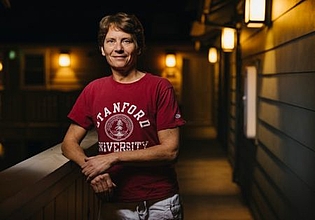News | Wednesday, 5 October 2022
Carolyn R. Bertozzi awarded Nobel Prize in Chemistry

Photo: Andrew Brodhead
The US biochemist and Leopoldina member Carolyn R. Bertozzi is being honoured with this year's Nobel Prize in Chemistry. Bertozzi receives the award together with Morten Meldal (Denmark) and K. Barry Sharpless (USA) for developments in so-called click chemistry and for fundamental contributions in the field of bioorthogonal chemistry.
To map important but elusive biomolecules on the surface of cells — glycans — Bertozzi developed click reactions that work in living organisms. Their bioorthogonal reactions take place without disturbing normal cell chemistry. These reactions are now used worldwide to study cells and follow biological processes. Using bioorthogonal reactions, researchers have improved the targeting of cancer pharmaceuticals, which is currently tested in clinical trials.
The President of the National Academy of Sciences Leopoldina, Gerald Haug, congratulates the US-American researcher: “Carolyn R. Bertozzi has taken click chemistry to a new dimension. With it, diseases such as cancer can now be investigated in a completely new way. She has been awarded the Nobel Prize in Chemistry for this groundbreaking research. We are delighted that this honour has once again been bestowed on a member of the Leopoldina.”
Carolyn R. Bertozzi (born in 1966) is considered a pioneer in the field of glycobiochemistry. She is concerned with the function of cell surface glycans. These sugar residues play a key role in cell communication and metabolism and change with various diseases. To observe this phenomenon in living cells, she has established a new field of research, namely bioorthogonal chemistry. With her interest in glycans, Bertozzi has entered a scientific terrain that had hardly been explored before. Presumably, a large proportion of all proteins are glycosylated. Carolyn Bertozzi wants to understand which role these sugars play in biological processes and how glycosylation patterns change specifically as humans age or as a result of disease. Methods for the early detection and therapy of cancer, infectious diseases or autoimmune diseases can then be developed on this basis. Specific observation of these molecules could not be achieved in the past but is possible now using the bioorthogonal chemistry developed by Carolyn Bertozzi. Here, molecules in living cells can be chemically modified in a way that allows observation.
Carolyn R. Bertozzi studied chemistry at Harvard University and received her doctorate from the University of California (UC), Berkeley, USA, in 1993. After a research stay at the American Cancer Society (ACS) in San Francisco, she taught chemistry at Berkeley as an assistant professor from 1996 to 2002. Since 2002, she has been a professor of Chemistry and Molecular and Cell Biology there. In 2006, she was appointed director of the Molecular Foundry at Lawrence Berkeley National Laboratory (LBNL). In 2015, she took up a professorship in chemistry at Stanford University and the Stanford Chemistry, Engineering & Medicine for Human Health Institute (ChEM-H Institute). Carolyn Bertozzi has been honoured with numerous awards for her scientific achievements. These include the Ernst Schering Prize 2007, the Albert Hofmann Medal of the University of Zurich 2009, the Tetrahedron Young Investigator Award for Bioorganic and Medicinal Chemistry 2011, the Heinrich Wieland Prize 2012 and the Wolf Prize in Chemistry 2022. Carolyn Bertozzi has been a member of the Leopoldina in the Chemistry Section since 2008.
The Nobel Prize in Chemistry is currently endowed with a total of ten million Swedish kronor (equivalent to around 920,000 euros). The prize money will be divided equally between the three recipients. All Nobel Prizes are traditionally bestowed on the laureates on 10 December, the anniversary of founder Alfred Nobel’s death.
The Leopoldina has more than 1,600 members, with a current 37 Nobel laureates among them.
